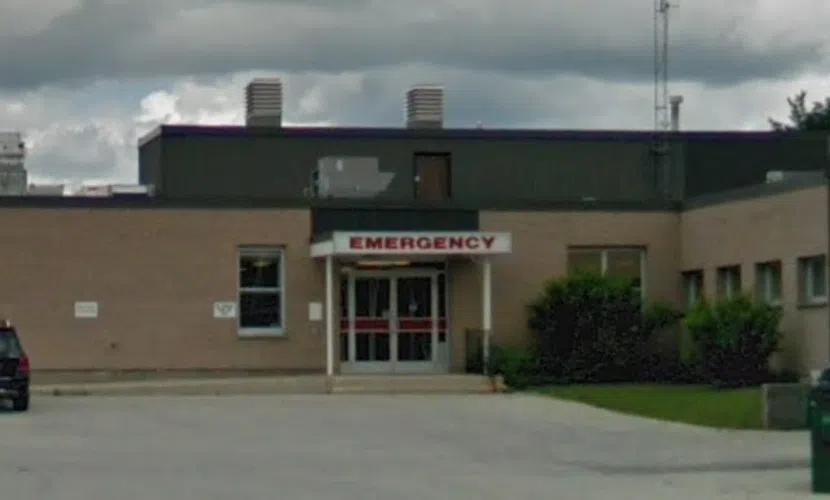The South Bruce Grey Health Centre has provided more information about the status of its staffing shortage in a series of public meetings.
It’s been giving community updates at a series of meetings in the area, the last of which is at the Walkerton Community Centre on Nov 20th at 6 p.m.
SBGHC, which runs hospitals in Kincardine, Walkerton, Durham and Chesley has also gathered up community feedback on its hospital services and put together a report.
The Chesley and Durham hospitals have seen service reductions over the past few years and Durham’s ten inpatient beds were moved out of the hospital this past summer and shared among the Kincardine and Walkerton sites.
South Bruce Grey Health Centre maintains that it does not currently have the staffing resources to maintain 24/7 emergency services at the Chesley and Durham sites.
It says in order to go back to full operation it needs to reduce its vacancy rate for registered nurses to zero. SBGHC says before moving Durham’s inpatient beds, the SBGHC average vacancy rate for registered nurses across all four sites was 44 per cent. It says now, its vacancy rate is 12 per cent as a result of reducing hours in Chesley and Durham and moving Durham’s beds.
The SBGHC says, from January to October 2024, they have hired 12 registered nurses (full time and part time positions, not including casual). They note, of the 12, two have been hired for the Chesley site (one single site, one dual site) and two have been hired for the Durham site (dual site). They say, “This is a notable increase over the previous two years, with more hires and less resignations/retirements.” Staffing numbers from SBGHC say in 2022, they hired ten registered nurses and there were nine resignations or retirement. In 2023 they hired six nurses and there were two resignations or retirements. In 2024, they’ve hired 12 nurses and there have been five resignations or retirements.
A dual site nurse works at more than one site, which SBGHC says is beneficial, explaining, “There have been circumstances where staff have been reassigned from the Walkerton or Kincardine sites to either Chesley or Durham to avoid a closure, and vice versa. As there are more staff at the Walkerton and Kincardine sites, there are many instances where staff have been pulled to avoid a closure at the Chesley or Durham sites.”
They say from April to August, they filled 341 shifts with agency nurse staffing, which is on average 2.2 shifts per day across SBGHC’s four sites.
The hospital organization has outlined a number of measures that may help with recruitment in its report. Notably, it says it’s participating in the Community Commitment Program for Nurses (CCPN), which provides a $25,000 incentive to eligible nurses in exchange for a two-year commitment to an employer. It’s also taking part in other grant and tuition reimbursement programs, job fairs, and training programs.
Meanwhile, they say over 800 people responded to their survey and hundreds attended meetings over the summer to give feedback and hear from South Bruce Grey Health Centre President and CEO Nancy Shaw.
The SBGHC’s report says “We hear you – it is evident that many people in our community would like to see 24/7 emergency care restored at the Chesley and Durham sites and for the inpatient beds to be returned to the Durham site.”
But it adds, hospitals around the province have significant staffing challenges, and in the local case Chesley and Durham in particular. They say, “As a result, we cannot commit to restoring these services at this time due to ongoing staffing
shortages. We must use our limited resources wisely to ensure we are maintaining consistent high-quality care for our patients.”
SBGHC says (keeping in mind there isn’t 24/7 ER service) some survey respondents said they wanted later emergency service hours, noting 36 per cent would like to see their ER open from 10 a.m. to 8 p.m.
Others wanted to see longer hours staggered between the Chesley and Durham sites, increased hours including keeping Chesley open on weekends or aligning diagnostic imaging hours with ER hours.
All survey questions were based on the assumption there would not be 24/7 ER service in Chesley and Durham.
Given that, if the Durham and Chesley sites were to be repurposed to provide other types of care, 75 per cent of respondents wanted primary or family doctors, 62 per cent wanted urgent care, 33 per cent wanted mental health and addictions services, and others wanted specialist clinics.
SBGHC says, right now, people are traveling outside the Durham and Chesley areas for specialist appointments like dermatology, ear, nose and throat specialists, gynecology and cardiology. They’re also traveling for family doctors and walk-in clinics, eye care, dialysis and mental health care.
It says, looking at what might be offered in Chesley and Durham, “SBGHC sees potential opportunities for enhanced access to care in the following areas: Echocardiograms, mental health services, outpatient lab services, urgent care, visiting specialists or hospice care.
They say they are looking at partnerships with local organizations to bring more services to the hospitals, like mental health services in Durham for example.
They also note there is a lack of access to primary care in the area and say, “While hospitals are not responsible for the delivery of primary care, we will be reviewing models in other communities that have effectively integrated these services with their hospital system and will work with our partners to advocate for enhanced primary care in our region.”




